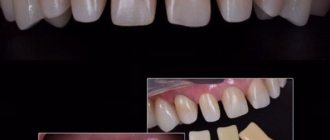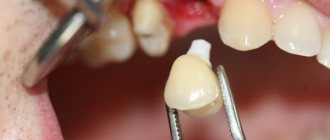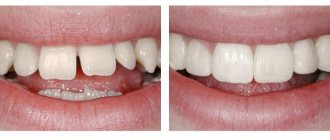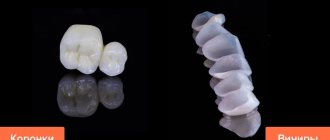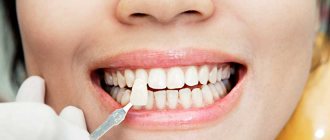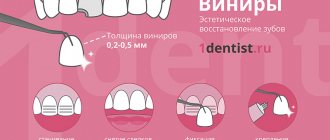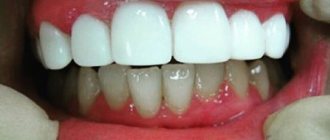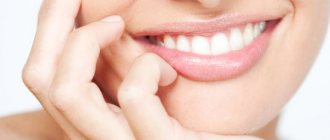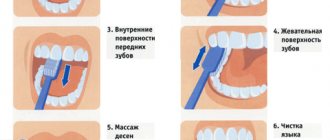324
Vining technology was first proposed in the thirties of the last century. However, due to the lack of durable and aesthetic materials for veneers, as well as reliable adhesives, it has not become widespread.
Currently, veneers are in some cases an excellent alternative to traditional full and partial crowns.
A little about the procedure
Preparation for veneers is the removal of the superficial vestibular layer of enamel. The grinding thickness depends on the location of preparation and the condition of the teeth, and ranges from 0.3 to 2 mm.
Preparation is necessary for the following reasons:
- To ensure a tight fit of the veneer to the problem unit if its shape is not ideal (tubercles, concavities, rotation).
- In order to prevent an increase in the size of the covered element. If you stick a veneer onto the enamel without grinding, the tooth will become thick and cause discomfort.
- To remove superficial carious lesions to prevent tooth destruction under the veneer.
Sometimes preparation is not performed. But this happens rarely, and only in certain cases. In particular, when the element is small in size due to wear or a growth defect. In this case, the veneer increases the volume to normal.
Uneven cutting edges and grooves may also make avoiding full preparation advisable. Standard grinding is not performed when installing lumineers that have a small thickness.
But even if classical preparation is not performed, light surface grinding of the enamel during veneering is still necessary.
When grinding of teeth for veneers is not required
There are times when you can do without turning the surface.
- The first case: the patient experiences severe abrasion of tooth enamel.
- The second case: an uneven, cutting edge is visible near the teeth.
- The third case: the tooth is in an incorrect position and you need to visually turn the tooth around.
- The fourth case: the teeth need to be added volume or grinding down will not lead to the desired result.
- Fifth case: installing veneers without turning will be more rational.
Disadvantages of fixation without turning
For the most part, patients agree with the technology proposed by the dentist - “specialists know best.” But some have an actively negative attitude towards preparation, believing (and quite rightly) that turning weakens the tooth.
In this case, the doctor needs to explain to the patient why fixing veneers without turning is considered undesirable:
- First of all, due to reduced adhesion. A natural element rarely has an ideal surface; it may have depressions and protrusions that prevent a tight fit of the veneer, and therefore strong adhesion.
Grinding makes the surface smooth, facilitating even distribution of the glue. - The possibility of a gap forming between the veneer and the tooth in the cervical area, where food debris can accumulate.
- Increase in volume by veneer thickness. This can cause discomfort and disrupt the functionality of the jaw apparatus, for example, negatively affect speech.
- Development of caries under the veneer due to remaining carious lesions from the surface of the unit.
- Color discrepancy between tooth and veneer if the first one is discolored.
Let's figure out together what color of veneers to choose and what factors should be taken into account.
Come here if you are interested in competent care for veneers.
At this address https://zubovv.ru/protezirovanie/nesemnyie-p/viniryi-np/snap-on-smile-reshayut-problemyi.html you will find real reviews about Snap on Smile veneers.
Features of installing removable plates
Fixation of temporary removable veneers is carried out by a dentist when the specialist needs a certain time to develop permanent plates. To do this, the patient must visit the dental office several times. The dentist performs important preparatory steps:
- treats the surface of a damaged tooth;
- makes impressions that are sent to the laboratory;
- If necessary, performs dental treatment.
Already during the second visit to the dental office, the patient receives a beautiful smile. To prevent damage to the surface of the teeth during the production of permanent veneers, the doctor recommends using removable structures.
Removable onlays (veneers) are made of special plastic that can protect teeth from increased sensitivity.
With their help, the patient gets the opportunity to see and evaluate how permanent veneers will look and correct their appearance in time. Important! The presented temporary plates are intended for short-term use, performing a protective function for an already treated tooth surface.
Techniques used
Preparation can be carried out in different ways. The choice of a specific one depends on the preference of the doctor, his training and experience, and the equipment available in the clinic.
Laser method
Laser preparation is one of the most modern methods. It has virtually no disadvantages, except for the need to have special equipment and a highly qualified dentist.
Its essence is that a laser beam is directed onto the surface of the enamel, under the influence of which the moisture in the enamel and dentin instantly boils , tearing off the smallest pieces of hard tissue, which are removed with a water-air spray.
The technique provides:
- high processing speed and accuracy;
- safety due to the absence of rotating elements, heating of dentin and eliminating the risk of injury to the gums;
- painless and silent procedure for the patient (no anesthesia required);
- disinfection of the preparation area (laser radiation is harmful to microbes);
- clean surface, no need for etching.
Ultrasonic
Odontopreparation of teeth with an ultrasonic instrument also has significant advantages compared to a rotary one.
An ultrasonic generator operating on the basis of the piezoelectric effect creates vibrations of the working body (nozzle) with a frequency of several tens of kilohertz.
High-frequency vibration easily destroys the enamel-dentin layer at the point of contact of the nozzle with hard tissues. Particles of destroyed material are washed off with water.
Ultrasonic preparation characterizes:
- absence of pain;
- low thermal effect (the pulp is not threatened by burns and necrosis);
- cleanliness of the treated surface;
- eliminating the risk of soft tissue damage.
Chemical
The chemical (chemomechanical) method is a complex procedure consisting of softening the hard tissues of the tooth with a gel containing sodium hypochlorite and organic acids , followed by scraping off the softened substance with a hand instrument. Rapid inactivation of the gel prevents the softening of an excessively large layer.
Chemical method:
- painless;
- does not heat bone tissue;
- keeps underlying layers healthy (without cracks or chips);
- Well received by patients who are afraid of the drill.
The disadvantage of the chemical method is its relative duration compared to other methods (several tens of minutes).
Tunnel
Tunnel preparation is a classic technology that involves controlled removal of a layer of enamel using a drill.
The working tool consists of a set of several cutters with spaces between each other. When the tool passes through the enamel, several grooves are cut, the depth of which is set by the difference in the diameters of the cutter and the axis on which it is mounted. The cutter cannot go deeper into the enamel more than the required value.
The bottom of the grooves is the maximum preparation depth. It is painted with some color that serves as a marker for further processing. When the color disappears (sands off), it means that the required depth has been achieved.
The main advantage of this method is the controllability of the layer removal thickness. Disadvantages include factors common to rotary instruments:
- Discomfort and pain due to vibration (requires local anesthesia).
- Danger of dentin overheating and pulp burns.
- Possibility of gum injury.
- Risk of cracks and chips.
Air abrasive
The air-abrasive method is based on the destruction of enamel with a point-focused jet of tiny (up to 50 microns) abrasive particles - aluminum oxide. The method is painless and safe, does not heat the tooth tissue, and is highly accurate.
The main disadvantage is the possibility of contamination, including bacterial contamination, of the treated surface.
An alternative to the air-abrasive method is the water-abrasive method. The presence of water in the flow eliminates dust formation and increases the cutting efficiency of the abrasive. Abrasive particles, enamel and dentin are automatically washed away. This method is recommended for use by the International Federation of Dentists (FDI).
Features of zirconium veneers on teeth and their disadvantages.
In this post, we will look at the pros and cons of feldspathic veneers.
Here https://zubovv.ru/protezirovanie/nesemnyie-p/koronki-np/obyazatelna-li-depulpatsiya-pered.html all the most important things about tooth depulpation before prosthetics.
Preparation methods
Let's look at the basic techniques for grinding teeth.
1. Laser preparation. By the name you can tell that a laser is used in the grinding process. These are mainly pulse devices. The laser causes intense heating of the water in the dental tissues. Due to the process, small cracks may appear on the enamel. They are removed using a water-air mixture. The laser grinding process takes place without noise. The procedure itself is safe. The main difference between laser turning is that the process is non-contact. The risk of infection is reduced.
2. Ultrasonic preparation. Wearing occurs due to the action of high-frequency vibration. The method does not have a negative effect on the pulp and the device itself puts little pressure on the teeth. Ultrasound stitching is painless. During the process, a small amount of heat is generated from the ultrasonic device. Therefore, strong heating of the surfaces does not occur. If the pin is screwed in, vibrations from the device do not cause chips and microcracks.
3. Tunnel stitching. The method involves the use of turbine dental units, in which the speed can be adjusted and the tips can be changed. The tunnel grinding procedure requires strict monitoring of device wear. The quality of installations affects possible overheating and tooth decay. The main advantage of tunnel grinding is considered to be control of the size of the removed layer and a correct forecast of the expected result. The disadvantages include severe pain when overheated and poor anesthesia. If you do not adhere to precise movements, you can damage soft tissues.
4. Air abrasive grinding. The simplest method, the essence of which is to use powder with abrasive elements. It is applied to the teeth with great pressure. As a result, the tooth layer is removed, that is, ground down. During the procedure, maximum dental volume is maintained. The whole process is quick and simple. Air abrasive grinding does not cause intense heat or unpleasant pain. The absence of mechanical shaking has a positive effect on dental tissue.
Also read: Basal dental implantation: features and stages of the procedure, cost
5. Chemical grinding. Hard method of preparation. Active acids chemically affect the teeth, making the enamel soft and subsequently allowing the layer to be removed. The process does not require pain relief. The tooth is not damaged by thermal exposure. Cracks and chips do not appear on the enamel. Some patients are very pleased with the lack of sound from the drill. The disadvantages of chemical exposure include the duration of the procedure.
The last version of turning is used on small children. It is problematic to treat baby teeth. Young patients are afraid of the sound of a rotating drill. And the very structure of a child’s tooth does not allow adult manipulations. Chemical exposure allows you to bypass this disadvantage and treat the dentition very efficiently.
The nuances of installing ceramic linings
The main materials for making veneers are ceramics and composite. In terms of the totality of properties, ceramics have an advantage over composites:
- Color and light transmission are as close as possible to natural enamel.
- Ceramics are completely biocompatible with oral tissues.
- Not colored with food dyes.
- Has high hardness.
- Thanks to the adhesive layer, it is resistant to cracking.
- Provides a long (up to 15 years) service life.
Preparation for ceramics has many subtleties that require careful planning of treatment taking into account the clinical situation.
The main parameters that receive increased attention are the following:
Thickness of the removed layer
In general, it is desirable that after grinding a layer of enamel remains, since the veneer is attached to it more firmly than to dentin. The thickness of the enamel on the vestibular surface is not constant.
On the neck it is smaller (0.3-0.5 mm) than in the middle of the tooth (0.6-1.0 mm) and on its cutting edge (1.0-2.1 mm). Therefore, the thickness of the veneer should also be different.
The optimal values are: on the neck - about 0.3 mm, in the middle part - 0.5-0.7 mm, on the cutting edge - 1-1.5 mm. Such values ensure the preservation of the enamel layer after turning.
Location of the preparation margin on the neck
The optimal position is considered to be one in which the lower edge of the veneer (preparation border) is located in line with the edge of the gum or goes deep into the periodontal sulcus to no more than half its depth. The cervical ledge should be located on the vestibular surface at an angle of 90-110°.
The amount of overlap of the processed area on the cutting edge
There are three options for this parameter:
- only the vestibular surface;
- vestibular surface and cutting edge with a slight approach to the palatal surface;
- vestibular surface and cutting edge with a large approach to the palatal surface.
The doctor chooses a specific option taking into account the shape and condition of the tooth. But in this case, one condition must be met: the border should not be located in the area of occlusal contact of the prepared element with the antagonist.
The thickness of the enamel removal on the cutting edge of the anterior units is 1 to 2 mm. Premolars must have a grinding depth on the chewing surface of at least 1.5 mm.
The amount of entry into the proximal region (interdental space)
To ensure good aesthetics, it is desirable that the preparation border is out of sight not only from the frontal view, but also from the side. The visibility of the lateral surfaces depends on the presence or absence of a gap between the teeth and their shape.
In general, depending on the morphology, it is practiced:
- small coverage (the veneer covers only the vestibular surface);
- medium (vestibular + ½ interdental space covered);
- large coverage (vestibular surface + entire interdental space).
In some cases, if the color of the natural units completely matches the color of the veneers, it is permissible to place the border of their contact in the visible area, that is, use a small coverage.
Indirect method
The indirect method involves making a veneer in the laboratory based on a tooth impression and then attaching it to the enamel using glue. Typically, indirect veneers are made from ceramic - sintered in an oven or cut from a ceramic block.
Preparation for them is usually done covering the cutting and lateral surfaces. The border in the cervical area should be located at the level of the gum or be slightly immersed in the gingival groove.
Direct method
With the direct method, veneers are modeled directly on the tooth in the patient’s mouth using a light-curing composite.
A direct veneer can cover the entire vestibular surface of the tooth or only part of it. In accordance with this, preparation can be either complete (including the side and cutting edges) or partial (only in those places where it is necessary).
Direct microprostheses are inferior to indirect ones in terms of strength and aesthetics, but they are installed faster and can be repaired directly in the oral cavity.
How many teeth can veneers be placed on?
Thin plates are almost never placed completely on the upper or lower row, since for chewing molars this solution is impractical and too expensive. Veneers are not able to withstand stress as well as crowns or implants.
Most often, veneers are placed on the front teeth, which are located in the “smile zone.”
Dental visibility includes 8 to 10 upper and lower teeth. In total, the maximum number of plates required for installation is 20. However, plates can be installed even if restoration of 1-3 teeth is required.
Reviews
Preparing teeth for veneers is the most difficult and unpleasant procedure for the patient. If it is performed with a rotary abrasive instrument, local anesthesia is used to reduce discomfort.
If you have ever had a tooth ground down for a veneer, tell us about the sensation. What method was used to prepare it, how long did the procedure last, was it painful? The comment form is located at the bottom of this page.
If you find an error, please select a piece of text and press Ctrl+Enter.
Tags veneers
Did you like the article? stay tuned
No comments yet
Preparation rules
Grinding of teeth for veneers should be carried out observing the following rules:
- Grinding vital (living) teeth requires anesthesia. Otherwise the process will be painful.
- Grinding of pulpless (dead) ones does not require anesthesia. An exception would be if the gums are pulled back using floss.
- Before carrying out the procedure, you need to take into account the anatomy of the teeth and soft tissues and predict their reaction. An x-ray will help you get a complete picture of the structure of the tooth.
- If rotated teeth are treated, then the protruding parts are first reduced, and only then proceed to the outer sides. The correct tooth shape is achieved by expanding the lingual boundaries and removing the enamel layer from the protruding areas.
- If there is a large gap between the teeth, the orthodontist independently determines the degree of treatment of the tooth. The correct dental shape is achieved by expanding the processing boundaries.
- If there is an anomaly in the dentition on the face, then the amount of work increases significantly. The outer protrusion is removed to the level of the arc, only after this the entire surface and cutting edge are processed. In this case, the entire tooth is ground down to the gum.
Also read: Clasp denture with clasps: what it is, what it looks like, features
When grinding of teeth is carried out under the influence of painkilling injections, unpleasant consequences arise after the procedure. The effect of anesthesia causes pain. Most likely this is due to the following points:
- When grinding a vital tooth, a small layer of tissue was left above the pulp. The pulp contains nerve endings that respond to external aggressors (hot and cold temperatures). There are several options: applying an additional cement layer or installing a temporary crown.
- If gum retraction is used during treatment, the soft tissues react strongly to compression. The pain subsides after a few days.
- If the above cases are excluded, but pain is present, then most likely pulpitis or periodontitis develops. These are dangerous diseases that require immediate attention to the hospital.
Stages
Like any procedure, tooth preparation before installing veneers consists of certain steps that the dentist follows. Each of them has its own subtleties in implementation, but is not necessarily applied in every individual case.
Grinding of teeth
In this case, the nuances of processing may vary depending on the structure and dimensional parameters of the tooth being processed. To understand the tooth preparation procedure itself, it is necessary to consider each stage separately.
It should be noted that the presence of carious lesions in teeth to be treated for veneers is an additional indication for expanding the preparation area. This is due to the fact that residual areas with caries will gradually lead to the destruction of the tooth stump on which the veneer itself is located.
Porcelain veneers were first used for aesthetic dental restoration. These products are considered reliable as they do not lose color or accumulate plaque.
You can read about the intricacies of teeth restoration with e-max veneers here.
Read about the wearing time of veneers and the need to replace them in this article.
Specifics of tooth treatment for various defects
Depending on the type of defect that needs to be corrected, the technique and degree of turning are selected. Only an orthopedic dentist can determine what action needs to be performed, since each case is special. Let's consider approximate preparation schemes in various situations:
- On inverted teeth, it is necessary to reduce the areas that protrude, then grind the outer side. The lingual boundaries must be expanded as much as possible to restore the shape of the tooth. To reproduce the ideal design, it is necessary to remove a significant layer of enamel from the protruding areas and cover the lingual area more thoroughly.
Also read: Zirconium dioxide: features and advantages of zirconium crowns
- Diastema or gap between the front teeth must be treated depending on the size of the gap. The specialist determines in a particular case what degree of processing is necessary to completely close the gap. The ideal shape is achieved by expanding the processing boundaries to the area where the teeth adjoin.
- If the tooth position is unnatural, the grind size increases . The protrusions of the outer plane are ground down to the dental arch, then the entire volume and cutting edge are completely processed. The entire tooth is ground down to the gum so that later there are no problems with the formation of the palatal area.
Unlike working with lumineers, turning for veneers is an integral part of the preparation. The intensity of exposure and technique are selected individually, based on the structure of the teeth, the degree and percentage of defects, and a number of other characteristics.
Since the procedure is painful, in cases where minor defects are present, it is advisable to limit the enamel to a light degree of treatment, making it rough for better adhesion to the material. When a slight correction is required, there is a need to build up the wall or slightly enlarge the tooth.
To obtain the ideal shape when working with veneers, the preparation procedure is important and guarantees complete adhesion of the working surface to the material.
